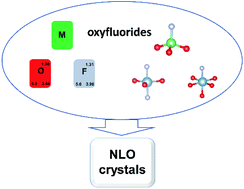Recent advances of oxyfluorides for nonlinear optical applications
Abstract
Nonlinear optical (NLO) crystals are key materials for solid-state lasers, which play an important role in modern science and technology. Recently, metal oxyfluorides have attracted much attention for next-generation NLO materials, in particular those used in the deep ultraviolet (DUV) and middle-infrared (MIR) regions. The incorporation of additional fluorine atoms allows new oxyfluoride-based NLO materials to span a more varied structure design palette than the oxide-only analogs. Therefore, metal oxyfluorides combine the advantages of fluorides and oxides, achieving wide transparent windows, large NLO coefficients, phase-match abilities, and high laser damage threshold values. For example, fluorooxoborates, fluorophosphates, fluorooxosilicophosphates, fluoroiodates, and fluorotellurites display new structural types and enhanced NLO performances. In this review, recently reported oxyfluoride NLO crystals are discussed. Their synthesis approaches, crystal chemistry, NLO performance, and structure–property relationship are reviewed. In addition, open challenges in both the synthesis and crystal growth of oxyfluorides are proposed. This work would provide a useful perspective on the exploration of next-generation NLO candidates with high performances to meet the urgent demands in DUV and MIR regions.

- This article is part of the themed collection: 2021 Inorganic Chemistry Frontiers Review-type Articles


 Please wait while we load your content...
Please wait while we load your content...